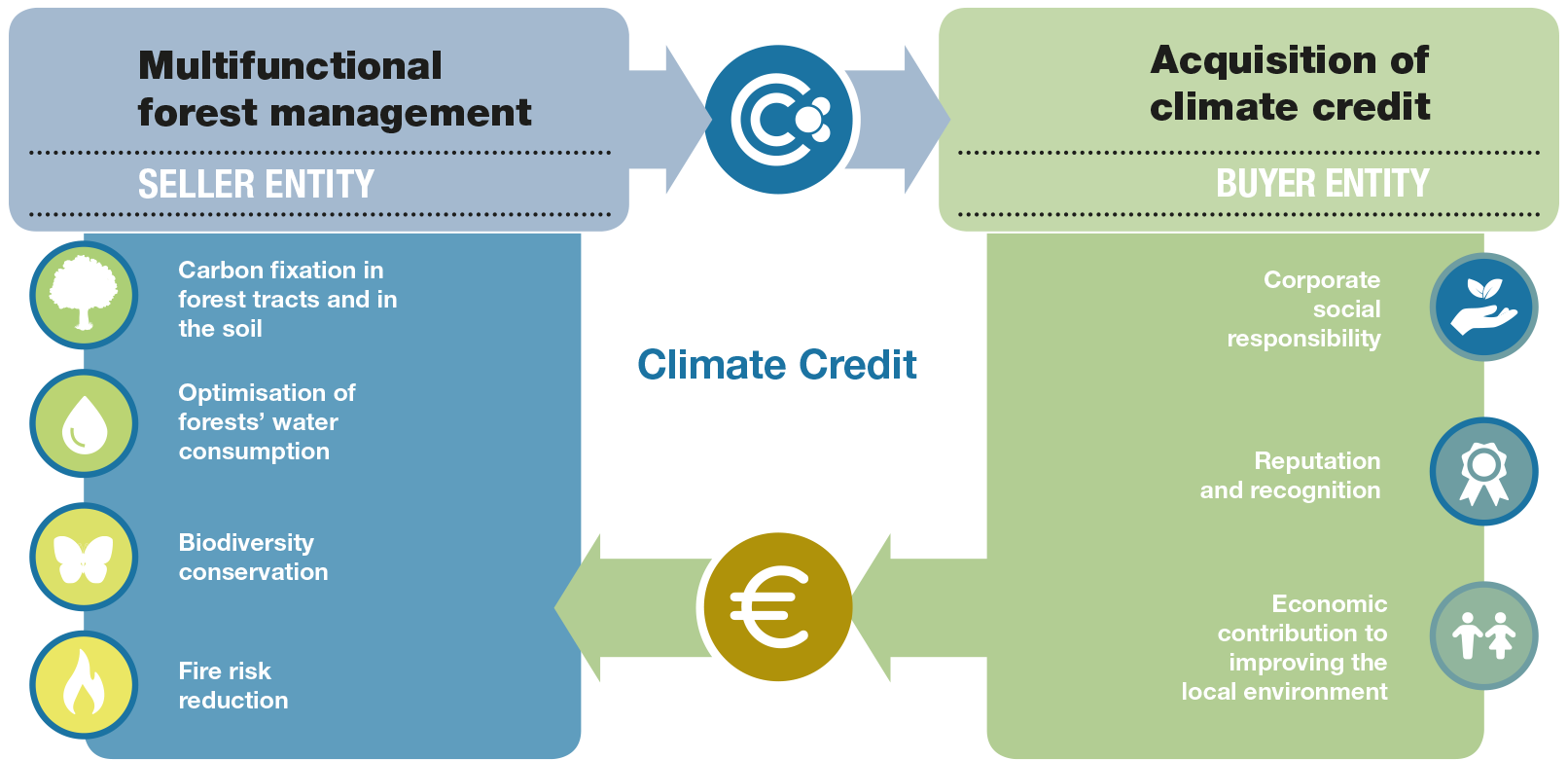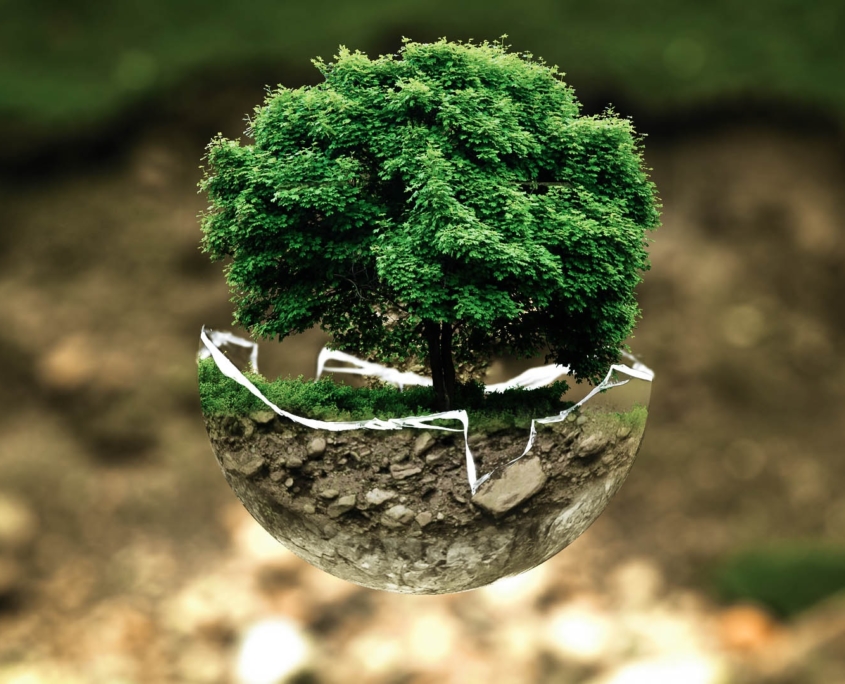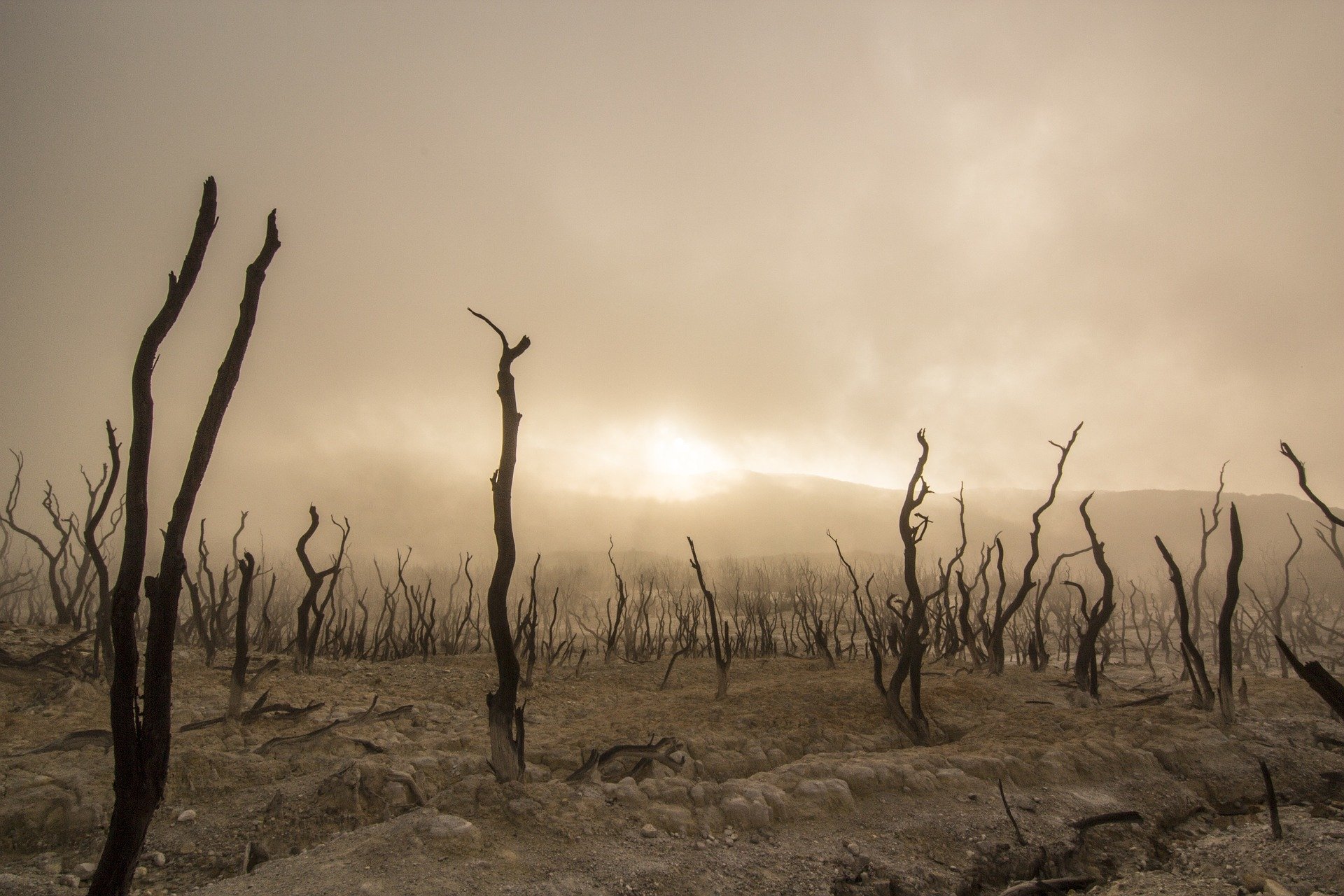What is Climate Credit?
Funding is basic to move any project forward. Life Climark proposes using the Climate Credit market to fund multifunctional management projects. Climate Credits are a new exchange unit designed to facilitate investment in nature-based solutions in Catalonia within the framework of voluntary offsetting and corporate social responsibility initiatives.
The basic idea is for companies to buy X climate credits, which are used to pay for all or part of a forestry project. For companies the Climate Credit mark constitutes a secure, controlled way of managing their contributions, ensuring visibility and transparency. For those managing woodlands, it is a way to diversify income sources for their work, based on the benefits their activities generate for society. Climate Credits offer companies an opportunity to offset their carbon and water footprints voluntarily by investing in forest management in Catalonia.
Climate Credits are based on a comprehensive concept of forest management. This means that, for forestry measures to generate climate credits, they must have a positive impact both on the mitigation of climate change and on adapting to it, and must do so in a way that corresponds to the local context. Landscape-scale prior planning is therefore needed, with the involvement of the main agents in the region. The indicators and methods used to calculate climate credits have a solid scientific basis and have been chosen using the instruments and tools available to forest managers, in line with cost-effectiveness criteria.
What are the advantages of multifunctional forest management?
Multifunctional forest management brings many benefits for society, and enables us to work to combat the climate emergency we are currently facing. At our latitudes and in the present circumstances, forest management focusing only on mitigation does not make sense: we must also develop means of adapting to the new climate conditions and preserving biodiversity, while ensuring the financial viability of woodlands.
Putting a truly multifunctional and climate-smart management system into practice thus means:
- producing renewable goods from local resources whenever possible,
- taking advantage of mitigation-adaptation synergies,
- incorporating criteria for conservation and greater biodiversity,
- taking the local characteristics of the region into account in a broad sense, in order to identify the most appropriate management options.
Climate credits are calculated by assessing the impact certain forestry practices have on 3 key factors in mitigating the effects of climate change and adapting to it in the Mediterranean area: climate, water and biodiversity, bearing in mind in all cases the contribution of such management to forest fire prevention. Forestry measures generating climate credits must comply with as many as possible of the following objectives:
CARBON
Carbon fixation to forest masses, the soil and its products
One of the goals we have set ourselves to reverse the current slowdown in European forests’ capacity to fix carbon. This involves applying smart and personalized forest management to each forest mass. The measures we finance are aimed at promoting the management of existing woodland and, where possible, the planting of new trees. With good planning, forest management can help to:
- conserve existing carbon stocks, for example with measures to prevent fire, encouraging the production of long-life woodlands and taking care not to damage woodland soil.
- maintain the forest’s capacity for carbon fixation, increasing its vitality by regulating competition for resources and, locally, by planting new trees where this is logical in ecological, technical and economic terms.
The production of locally sourced renewable raw materials like timber or cork contributes to the replacement of fossil fuels and materials, thus contributing to the targets for decarbonizing the economy envisaged in policies on climate change and promoting the bioeconomy.
WATER
Reducing water consumption in woodlands
One of the main consequences of climate change in Catalonia is a reduction in water resources. Having woodlands that can consume less water is thus a key factor in being able to adapt to reduced precipitation and more frequent drought.
Measures are being taken with a view to regulating the number of trees in woodland located in river basins where surface water is exploited or over aquifers, which are a strategic element in maintaining stable supplies of water in the region. If the number of trees is reduced, they capture and consume less water, so that more is released into the river basin.
We need to achieve a balance that enables us:
- to increase the amount of water filtering back into aquifers and rivers, wherever possible.
- to ensure that water is consumed more efficiently by woodlands.
- to maintain healthy tree cover to control flooding and guarantee the quality of water.
BIODIVERSITY
Biodiversity conservation and improvement
At Life Climark, in addition to supporting the conservation of biodiversity, we want to make a decisive contribution to enriching the biodiversity of the forest areas managed.
We aim to foster an approach to management that protects and increases woodland biodiversity. This can be done, for example, by keeping large diameter trees when felling or generating dead wood, thus providing a habitat for a wide range of organisms. Biodiversity can also be enhanced by planting new species suitable for local conditions.
According to the stage of development of each area of woodland, based on a prior diagnosis using the Potential Biodiversity Index, we can determine the most effective measures for each stand.
FIRE
Reducing fire risk
Large forest fires have serious effects on landscape, biodiversity and the social and cultural services related to them, and they endanger human life. A forest that is more vulnerable to fire endangers the work it has done over decades to fix carbon.
The measures we encourage with climate credits include increasing the ability of woodland to resist forest fires, which will be more frequent and more serious because of climate change. We hope to optimize the structure of the most vulnerable woodland to increase its resistance to fire, prevent major forest fires and improve prospects for the regeneration of tree cover following a fire.
In areas with a high risk of fire, appropriate measures may include a reduction in total biomass and the introduction of fire breaks to prevent crown fires and reduce the intensity of any outbreak. If these measures are implemented at Strategic Management Points identified by the fire service, they will also help to reduce the risk of a major fire that cannot be contained.
Organization buying climate credits
What’s in it for companies?
The climate credits market is intended to facilitate CSR and carbon offsetting initiatives, in relation to the climate crisis and its impact on Catalonia’s woodlands.
When you buy climate credits, you provide extra funding which is essential for smart forest management measures to be implemented regarding climate issues. Climate credits enable you to:
- manage the impact of your activity comprehensively, considering not only CO2 emissions but also water consumption and/or its impact on biodiversity.
- exercise your joint responsibility towards sustainable development and the natural environment in the region where you operate, generating quality employment.
- improve the company’s image by associating the brand with mitigation and adapting to climate change, including the prevention of forest fires, the conservation of woodland and its biodiversity and, in short, keeping a landscape and a region alive.
- invest in reputable CSR, characterized by transparency and visibility, through the Crèdit Climàtic brand.
CSR
Corporate Social Responsibility
Companies are not isolated from the world but form part of society. As such, they should help to make society wealthier and more sustainable and make the world a better place to live in.
By supporting Life Climark and its climate credits companies can improve their image, as their customers and society as a whole will see that they are acting positively and decisively to improve the environment and assist rural development, generating quality jobs.
COMPANY IMAGE
Reputation and recognition
The company image goes far beyond the logo. The brand is built on all the actions taken by a company. Actions such as sponsoring a sustainability initiative, like Life Climark, will be highly positive for the brand, as the public will see that the company is committed to values such as the fight against climate change, ecology, and care for the environment, the region and its landscape.
IMPROVEMENT OF THE ENVIRONMENT
Financial contribution to improving the local environment
Inevitably, a company has an impact on the area in which it is established. Buying Climate Credits from Life Climark you will be participating in a project that aims to improve and care for the region and the environment.
Entity that offers its land / sellers
WHAT ARE THE BENEFITS FOR FOREST OWNERS?
Life Climark is meaningless without a forest or a place to act. In Catalonia, most forests are privately owned, so we need the cooperation of forest owners.
At the Life Climark consortium we work to increase the efficiency and viability of climate-smart multifunctional forest management:
- Offering you an entry to environmental funding circuits via the creation of a voluntary credit market which goes beyond carbon credits: climate credits.
- Making the necessary tools available to foresters and their associations, so that they can:
- identify the forestry measures – and locations – that will have most impact on the objectives of mitigating/adapting to climate change.
- calculate the impact of their management on the carbon balance, water supplies and biodiversity, and the climate credits generated by the management policies applied.
TAKING CARE OF YOUR LAND
Multifunctional Forest Management applied to your property
Maintaining a forest is not easy or economical and there are many reasons for managing it: from safety in view of the risk of fire or drought to the production of assets, improving the landscape and increasing biodiversity.
A forest owner cannot afford to maintain the ecosystem services required of woodland today without help. Making the climate credits you generate with your management available to the market makes it possible to channel society’s joint responsibility for the maintenance of these services and may make the difference between being able to apply sustainable management or not.
Climate credits can help you to look after your woodland, as you are helping to improve its ability to absorb carbon, generate water, encourage biodiversity and, in short, tackle the current climate crisis.
PROMACC projects
Management of the region based on local participation and joint governance
At Life Climark we are convinced of the major role forest management can play in creating landscapes that will be more resilient in the face of climate change. We also believe in the need to plan this management according to the overall demands of the region in which it is applied.
Landscape-scale planning will, therefore, be the basis for “Forestry Projects for Mitigating/Adapting to Climate Change” (PROMACCs), which will serve as a vehicle for climate credit transactions in the new voluntary market.
These projects can be presented by associations of forest owners or other agents who can work together to promote the management of a particular area. The PROMACC projects will include a schedule for all the forestry measures to be taken in the area over a maximum period of three years, plus a calculation of the climate credits they will generate, which will be made available to companies or organizations that wish to buy them in the new market.
At Life Climark, we understand a PROMACC as:
- a project that depends on voluntary support and helps to highlight the forest ecosystem services in a particular area.
- a project based on landscape-scale planning, which establishes priority measures in line with climate change mitigation/adaptation criteria according to the development goals of that particular area.
- a project based on collective forest management, in a spirit of cooperation, equality and solidarity.
Follow us on Twitter
Follow us on Facebook

There are no objects in this facebook feed.
The Forest Ownership Centre
Finca Torreferrussa
Ctra. B-140, Sabadell a Santa Perpétua de Mogoda, km 4,5
08130 Santa Perpètua de Mogoda (Barcelona)
Phone: 935 747 039 – Fax: 935 743 853
E-mail: info@lifeclimark.eu


















